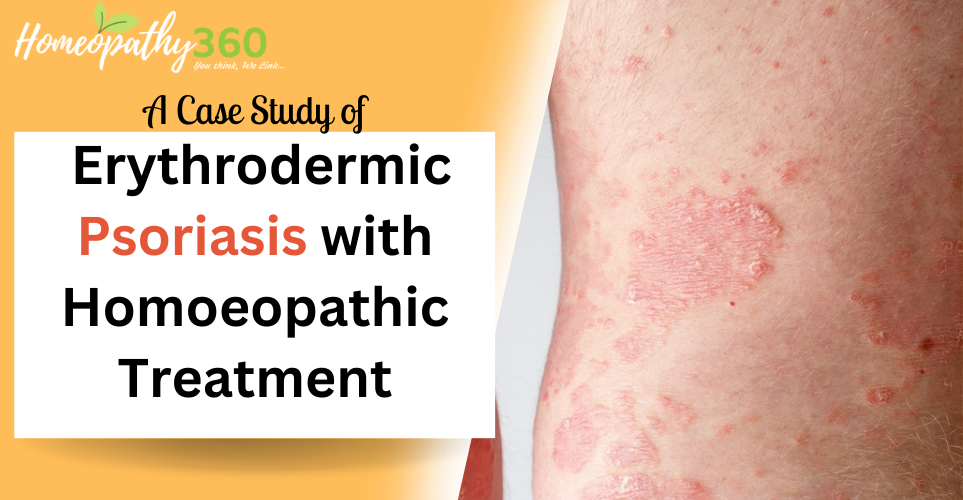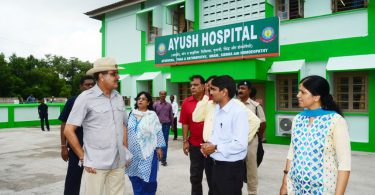
ABSTARCT– Psoriasis is a common inflammatory disease which is immune-mediated, genetic disease manifesting in the skin or joints or both. It is affecting approximately 2–3% of the world population. In India, its prevalence in adults varies from 0.44 to 2.8%. Twice more common in males in their 3rd or 4th decade at the time of presentation. Psoriasis provides many challenges including high prevalence, chronicity, disfiguration, disability, and associated comorbidity. It is characterized by erythematous plaques covered with silvery scales, particularly over the extensor surfaces, scalp, and lumbosacral region. The disorder can also affect the joints and eyes.
Many Homoeopathic remedies have been prescribed according to Totality of symptoms as per case and reports have also been published.
KEYWORDS – Psoriasis, Auto-immune, Homoeopathy.
DEFINITION– Psoriasis is a chronic [long-lasting] disease in which the immune system becomes overactive, causing skin cells to multiply too quickly.
There are several types of Psoriasis including:
- PLAQUE PSORISIS- It is the most common type of Psoriasis and about 80-90% people suffer with this type.
- INVERSE PSORIASIS- this type appears in your skin folds. It causes thin plaques without scales.
- GUTTATE PSORIASIS- may appear after a sore throat caused by a streptococcal infection. It looks like small, red, drop-shaped scaly spots and often affects children and young adults.
- PUSTULAR PSORIASIS- It has smell, pus-filled bumps on top of plaques.
- ERYTHRODERMIC PSORIASIS- this is a severe type that affects a large area(>90%) of your skin. It causes widespread skin discoloration and skin shedding.
- SEBOPSORIASIS- This type typically appears on your face and scalp as bumps and plaques with a greasy , yellow scale. This a cross between psoriasis and seborrheic dermatitis.
- NAIL PSORASIS- In skin it causes pigmentation and pitting.
Epidemiology–. Psoriasis is affecting approximately 2–3% of the world population. In India, its prevalence in adults varies from 0.44 to 2.8%.
Case summary
A case of 55 yr. an old male presented in OPD with following complaints, first appeared in hand .Itching ,burning ,non stop itching gradually increased , unhealthy scaly red eruption all over body , first appeared in hand then all over the body .
Character of the lesion is severe itching eruption with discoloration, on back side , neck, red, patches.
- Complaints aggravate in winter, at night.
- Patient had Diabetes mellitus.
- Thermal reaction of the patient was chilly.
- He has a craving for sweet and salt.
- generally sleep was disturbed with itching.
- Patient was forgetful, confused, anxiety with little impressions like noticed by others, wants to stay at home
- After repertorial totality medicine was prescribed.
Physical Examination
- Appearance pale, dark complexion, his vital signs were normal.
- Clinical findings: red scratchy scabs over back ,nape of neck.
Basis of Prescription
Sulphur 1M was prescribed on the basis of reportorial totality. As it was most similar to the case and scored highest 7/9. He was forgetful, anxious when observed by others, desire for sweet and salt , a chilly patient directed to the prescription of sulphur.
1st Prescription and Follow Up
- Sulphur / 1 dose, every 15th day.
- PL pills.
| 1 | Sleep no change, itching and rednessdecreased. | placebo |
| 2 | Sleep was improved, itching and rednessfurther reduced. | placebo |
| 3 | Generals improved, with further improvementin itching and redness. | placebo |
Discussion
In this case, the patient who received homoeopathic treatment did considerably better than the previous time. Homoeopathic treatment was given according to an individualistic approach. Remedy was selected on the basis of symptoms similarity after analyzing the repertorial totality. Homoeopathic treatment is more cost effective having no further associated symptoms. There are limitations for homoeopathy like unavailability of proper potency of well selected remedy in some cases. Here in this case 1M potency was selected according to the patient’s susceptibility. Few doses of selected potency were required here which worked beneficially. We the homoeopathy physician should always consider the potential of a single remedy in a case.
Conclusion
Firstly, the diagnosis of Psoriasis disease might be an explanation for a person’s skin symptoms, which was unexplained previously. Knowing the cause of their skin condition can help individuals to better manage their symptoms and more effectively understand their body. Secondly, as there is no cure for Psoriasis disease, there are treatments available to alleviate symptoms and improve the appearance of the skin. With proper treatment in homeopathy may help individuals with Psoriasis disease to lead a relatively normal life. Finally, a sense of community and connection with others having Psoriasis disease. Online forums and Support groups provide a space for individuals with similar conditions (Psoriasis disease) to connect with others, share experiences, and offer support and advice. In conclusion, being a challenging condition to manage, having some positive aspects to the condition, including a sense of community, effective treatments, and a better understanding of one’s body. With proper support and management, individuals with Psoriasis disease can lead a full and satisfying life. So, in homoeopathy having promising results which are beneficial and cost effective as well for a patient. Likewise furthermore research should be done to establish its efficacy in any diagnosed case.
Conflict of Interest
Not available
Financial Support
Not available
REFERENCES:
| 1. | Rajagopalan M, Chatterjee M, De A, Dogra S, Ganguly S, Kar B, et al. Systemic management of psoriasis patients in Indian scenario: An expert consensus. Indian Dermatol Online J [Internet]. 2021 [cited 2024 Mar 1];12(5):674. Available from: http://dx.doi.org/10.4103/idoj.idoj_113_21 |
| 2. | informa- P. American academy of family physicians.) [Internet]. Psu.edu. [cited 2024 Mar 1]. Available from: https://citeseerx.ist.psu.edu/document?repid=rep1&type=pdf&doi=288edf0e9df0f3b3bdb5547391eb82f1f3a6ee7a |
| 3. | Boehncke W-H, Schön MP. Psoriasis. Lancet [Internet]. 2015 [cited 2024 Mar 1];386(9997):983–94. Available from: https://pubmed.ncbi.nlm.nih.gov/26025581/ |
| 4. | Nair PA, Badri T. Psoriasis. 2024 [cited 2024 Mar 1]; Available from: https://pubmed.ncbi.nlm.nih.gov/28846344/ |
| 5. | Psoriasis [Internet]. Cleveland Clinic. [cited 2024 Mar 27]. Available from: https://my.clevelandclinic.org/health/diseases/6866-psoriasis |
DR. RAVINDRA RAJORIYA
{ MD SCHOLAR }
Dept. of practice of medicine
Govt. Hom. Medical College, Bhopal.
DR. PRAVEEN JAISWAL
{M.D.(Hom.)}
H.O.D. (Dept. of Practice of Medicine)
Govt. Hom. Medical College, Bhopal.


